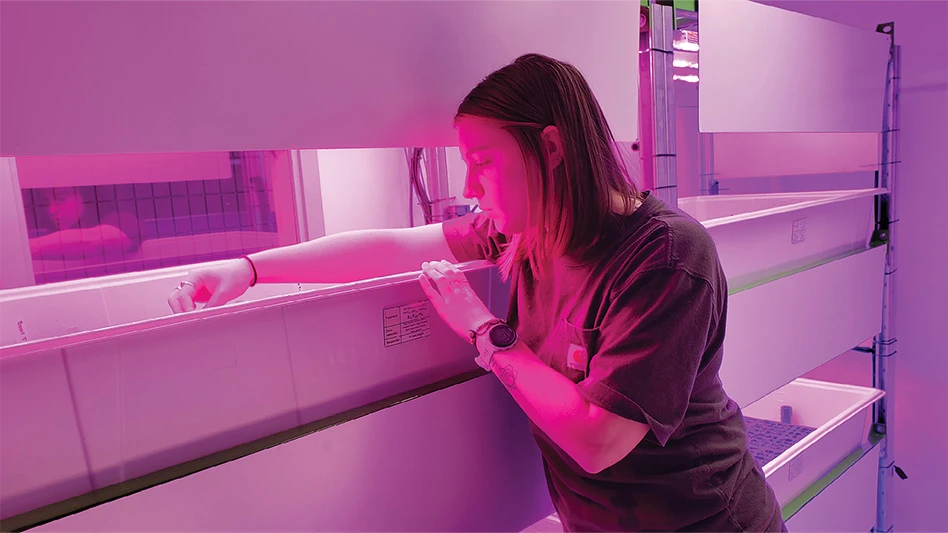

Emma: Weed control is a constant battle for greenhouse and nursery growers. Can you tell us about some of the key weed species we run into in indoor production and why they are problematic?
Chris: Despite our best efforts, weeds will usually find their way into a greenhouse by some way or another. The greenhouse is a perfect environment for many different weed species but certain species like bittercress (Cardamine spp.), woodsorrel (Oxalis spp.), and liverwort (Marchantia polymorpha) can really thrive and spread exponentially inside a house. Bittercress and woodsorrel grow fast, produce many seeds, and the seed pods explode when they are ripe, spreading the weeds throughout the house. Liverwort is problematic mostly because it loves two things: moisture and nitrogen. Propagation mist beds are perfect for liverwort. Liverwort spreads both vegetatively and via spores, and can spread throughout a house extremely quickly. It is also almost impossible to hand weed. Once any of these species gets into the actual crop, there isn’t much that can be done other than manual removal.
Emma: So frequent scouting, along with strict sanitation practices, is critical to keeping weed populations in check. Despite our best efforts, sometimes weeds can get the upper hand and unfortunately, there are relatively few herbicides that are labeled for use indoors due to volatility concerns.
Chris: Certain herbicides that have high vapor pressure can turn into a vapor after they have been sprayed (or applied as a granular) and these vapors can injure plants. This is problematic for fully enclosed greenhouses because the vapors get trapped inside. Whereas something like a shade house (only covered in shade cloth) doesn’t pose the same concern because vapors can dissipate more easily. Plants that are treated with preemergence herbicides and moved inside a house soon thereafter are also susceptible to volatility injury. Ensure that the herbicide that is being used inside the house is labeled for that use. Also, make sure to time your preemergence application so that it is made at least 2 to 3 weeks (depending on label) before you have to move the plants inside.


Emma: Herbicide options for enclosed structures are fairly limited but there are great options available. Post-emergent herbicides like glufosinate (Finale® XL T&O herbicide) can be used indoors while plants are present. This allows for cleaning up weeds under benches, along walkways and around equipment.
Chris: Other post-emergent herbicides include diquat (Reward) and Scythe or Axxe (pelargonic acid/ammonium nonanoate). These are all contact or minimally translocated herbicides so thorough coverage is needed for control. Be sure to turn off air circulation fans during the application. For grassy weeds, clethodim (Envoy Plus) and fluazifop-butyl (Fusilade II) could be used. Indaziflam (Marengo) is a broad-spectrum preemergence herbicide that could be applied either alone or in a tank-mix with a postemergence herbicide on the floors or under benches to prevent weeds from coming. When the house is empty (and will be for 24+ hours), you have a few more options such as glyphosate (RoundUp Pro and others) for postemergence control and flumioxazin (SureGuard) for preemergence control.
Emma: When we start talking about herbicides for outside the greenhouse or even outdoor production areas, we definitely have more options. What should growers consider when selecting herbicides for outside and around the greenhouse?
Chris: Poor weed control outside of the greenhouse will inevitably lead to poor weed control inside the house. Frequent mowing, weed fabric, gravel, basically just general sanitation, are good practices to keep weed pressure low. Most of the postemergence herbicides labeled for use in and around ornamentals in nurseries can be used around a greenhouse, but the main thing you want to avoid is the use of volatile herbicides that could drift into the house through doors, vents, etc. A major herbicide group to avoid is the auxin type herbicides like 2,4-D and dicamba. These are mostly used in turf and can be prone to volatilization. Soil sterilant herbicides like dichlobenil (Casoron) should also be avoided when treating in close proximity to production areas. It is always a good idea to shut vents and windows when treating large areas around the house.
Emma: In addition to weeds being an unsightly greenhouse pest all their own, weeds can also serve as harbors for insects and other pests and can act as additional hosts for some plant pathogens like impatiens necrotic spot virus (INSV) and tomato spotted wilt virus (TSWV).
Jen: Greenhouse weeds also provide a significant reservoir for insect and mite populations to build and thrive. They can be missed with spray applications, and even fogs and beneficials may not reach spider mite nurseries under the bench, or thrips, whitefly and aphid populations living in weedy corners or behind greenhouse structures. Don’t forget that algae is also a greenhouse weed, and it feeds and harbors shore flies and fungus gnats, allowing them to lay more eggs and be present in the range all year long. These flies and others associated with wet conditions, like drain flies, are not only plant pests and nuisance pests as they dart around workers’ faces, they can also move pathogens between plants and crops.

Explore the August 2021 Issue
Check out more from this issue and find your next story to read.
Latest from Greenhouse Management
- CEA Alliance celebrates bipartisan introduction of Supporting Innovation in Agriculture Act
- Dümmen Orange North America celebrating 25th anniversary in 2025
- CEA HERB Part 1: Best management practices for culinary herbs
- Lawsuit challenges new H-2 visa rules
- CEA HERB Part 2: A guide to increasing the sowing density of culinary herbs
- Illinois Landscape Contractors Association changes name to Landscape Illinois
- 2025 Proven Winners Horticulture Scholarship applications now open
- ICL’s Gemini Granular herbicide now registered for use in California







